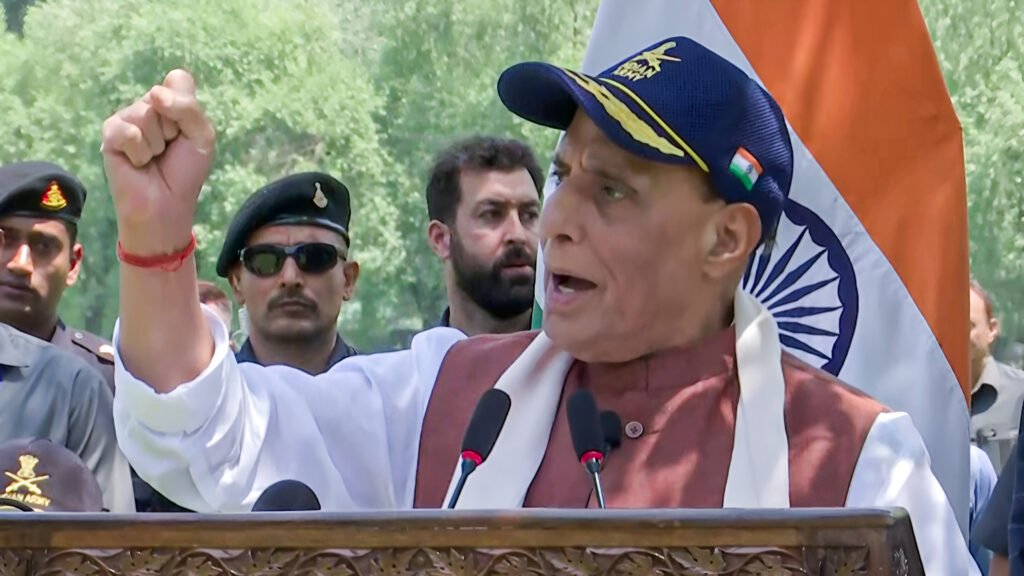
Operation Sindoor: A Leg Up in India’s Security Doctrine
May 2025 marked a key chapter in the advancement of India’s security framework with the launch of ‘Operation Sindoor,’ which followed the Pahalgam Temple massacre wherein 26 Hindu pilgrims were brutally slain. It transformed the Indian approach of strategic restraint, whether in active or passive form, with engagement in proactive measures. The Indian Air Force, alongside live satellite support and modern munitions, executed precision assaults on nine terrorist bases in Pakistan as well as occupied parts of Kashmir, including major hubs in Bahawalpur and Muridke, which are considered to be the epicenters of Jaish-e-Mohammed and Lashkar-e-Taiba. This immediate and calculated action demonstrated India’s determination to eliminate the terror bases of infrastructure without devolving into a war.
Rajnath Singh’s Visit to Bhuj Airbase: Acknowledgement of the “Wings of Air”
Singh’s address on May 16 to the IAF ‘Air Warriors’ stationed at Bhuj reinforced the claim of the government appreciating the execution of Operation Sindoor. Not only did the minister appreciate their effort but also stated how commendable the service is. His commentary, “23 minutes to crush terror,” illustrates how the mission was executed with impressive speed, highlighting to the public that India’s armed forces stand ready to respond to any threats directed towards the country’s security.
Precision and Technology: The Backbone of the Operation
Operation Sindoor epitomized India’s advancing military capability of precision attack with sophisticated technology. The IAF sent Rafale jets armed with SCALP and HAMMER missiles, BrahMos cruise missiles, as well as loitering munitions designed to strike deep terror targets beyond borders and execute surgical strikes against terrorist assets. It also confirmed the effectiveness of the upgraded Indian airspace defense systems comprising the Akash missile systems and the S-400 ‘Sudarshan Chakra,’ which remarkably intercepted Pakistan’s retaliatory threats. This ensured precision collateral damage and no civilian casualties, which set a new standard for operations of this kind.

Strategic Impact: Redefining Deterrence and Escalation Control
The approach taken by India in Operation Sindoor was marked with strategic calm and decisive force at the same time. By focusing only on terror strategic objectives, with no Pakistani military objectives, India made it clear that her aim was not to ignite a full-scale war but to eliminate terror infrastructure. The successful operation conducted in 23 minutes underscored how deep-strike missions could be executed by India while still being able to control escalation… something most critical in the region’s security dynamic.
Development of Indigenous Defense Capabilities and the ‘Make in India’ Initiative
Operation Sindoor demonstrates increased combat effectiveness with the use of indigenous defense technologies like the Pinaka artillery, advanced electronic warfare systems, and Harop drones, as well as new and emerging technologies. These self-sufficient platforms not only furthered operational effectiveness but also advanced India’s aspiration of becoming a net arms exporter. Several Asian, African, and Latin American nations are now interested in these defense technologies, reinforcing the notion of ‘Make in India’ and ‘Atmanirbhar Bharat’ initiatives in the global defense market.
Sociopolitical and Diplomatic Aspects: A New Red Line
Civilians, particularly those of Indian origin, are not to be targeted for violence masquerading as religious zeal, and if such attacks take place, they will be met with a merciless military response, as explained by Prime Minister Modi and Defense Minister Singh. Therefore, paying for terrorism is now more expensive than ever for both state and non-state actors, as illustrated in India’s counter-intervention terrorism strategy with Operation Sindoor. Their move garnered the attention of the entire world, with the United States and other concerned parties calling for restraint while simultaneously accepting India’s self-defense prerogative.
Conclusion: India’s Watershed Moment in Terrorism
Operation Sindoor embodies the growing confidence and competence of India in the realm of military operations heavily reliant on diplomacy, deep politics, and trade. Rajnath Singh praising the IAF at Bhuj Airbase implicates, in commemorating the gallantry of the air warriors, the national determination to defend the people from terrorism. The remarkable operative achievement of “23 minutes to crush terror” will most probably influence India’s security strategy and deterrence policy for many years.











